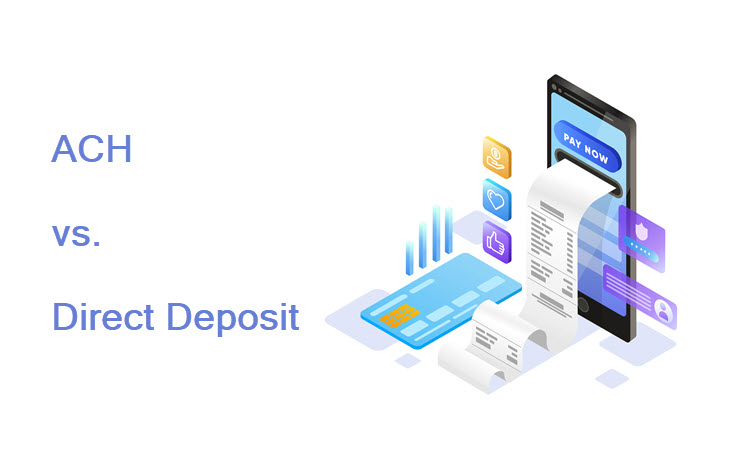The dynamic online landscape today requires effortless payment processing with fast transactions and efficient deposit times. Whether customers are buying goods and services, paying their bills, or setting up a subscription, a variety of secure payment options is essential for the smooth movement of money.
ACH transfers and direct deposits are among many customers’ preferred payment methods, allowing for the easy and fast transfer of funds from one account to another.
In this article, learn about ACH payments and direct deposits, their similarities, and differences.
What Are ACH Transfers?
ACH transfers are electronic money transfers from one bank account to another. They are an alternative to cash or physical checks and are processed through the Automated Clearing House (ACH) Network. The ACH includes several thousand financial institutions and ensures that all transaction requests are verified, and the money is processed securely.
There are two main types of ACH transfers: direct deposits and direct payments.
Note: The two main parties in an ACH transfer are the originating depository financial institution (ODFI) and the receiving depository financial institution (RDFI). For more on the parties involved in the process, read our article ODFI vs. RDFI – Definition and Differences.
What Are Direct Deposits?
Direct deposits are a type of ACH transfer made to an individual’s checking or savings account from an employer or a state or federal agency. As with any other ACH transfer, direct deposits are processed and verified via the ACH network.
Direct deposits have helped organizations discard paper checks and pay employees quickly and conveniently. Other benefits of using ACH direct deposits include low fees, ease of use, and safety.
Note: Direct deposits are similar to wire transfers but there are notable differences. For more on this, check out our article Direct Deposits vs. Wire Transfer.
ACH vs. Direct Deposit: Similarities and Differences
ACH payments and direct deposits are similar, and the terms are sometimes used interchangeably. There are, however, a few differences between these two transactions.
Similarities

Here are the similarities between ACH transfers and direct deposits:
- ACH network processing. The ACH network verifies and processes both ACH transfers and direct deposits.
- Processing times. ACH transfers and direct deposits typically take 1-3 business days to clear, after which the money becomes available on the receiver’s account.
- Security. ACH and direct deposits are more secure than cash payments or paper checks, which can be forged, stolen, or lost.
- Insufficient funds fee. Both ACH and direct payments come with an insufficient funds fee in case the payer does not have enough funds for the payment request to be completed.
Note: ACH payments are processed faster than other payments. To learn more about ACH processing times, refer to our article ACH Payment Processing Time: How Long Does It Take?
Differences
Below are the key differences between ACH transfers and direct deposits:
- Scope. Direct deposits are a type of ACH payment and are more limited in scope. They are not suitable for payments that need additional verification, such as external funds transfers, or recurring payments. Direct deposits primarily substitute paper checks and cash.
- Withdrawals. ACH transfers allow both deposits and withdrawals of money through a bank account. On the other hand, direct deposits, as the name suggests, only allow deposits.
- Fees. Per transaction, an ACH transfer costs between 0.5% and 1.5% of the total transaction amount. There is also a monthly service fee ranging from $15 to $30. ACH reversals cost between $2 and $25. On the other hand, the processing fee for direct deposits is between $1.50 and $1.90 per transaction. Banks charge businesses between $50 and $149 for the initial setup of the service.
Note: ACH transfers are often free, depending on the amount and the type of money transfer. ACH money transfers are much more convenient and cheaper than wire transfers.
ACH Payment vs. Direct Deposit: Which One Should You Use?
ACH Payment
ACH transfers are best suited for low-value, long-term payments because many require only a one-time authorization. The following transactions are typically done as an ACH transfer:
- External funds transfers. Electronic money transfers between different bank accounts and financial institutions.
- Peer-to-peer payments. Payments from a personal bank account to another person’s account (e.g., sending money to friends and family or for shopping online).
- Bills. The settling of recurring bills, such as utilities, car payments, cell phone bills etc.
- Subscriptions. Regular payments by subscribers for a product or service. ACH transfers are a cheap and convenient payment method subscription businesses can use to bill their customers. The primary benefit is that ACH transfers are far less expensive than credit card transfers.
- Recurring donations. ACH transfers are great for making recurring donations.
Note: Learn what it takes to start processing ACH payments in our article How to Accept ACH Payments.
Direct Deposit

Direct deposits remove the need for paper checks. They are much faster to process, safer, and are typically used for following transactions:
- Salaries and wages. Paychecks deposited directly to the employee’s bank account.
- Employer-reimbursed expenses. Reimbursement for travel expenses, meals, uniforms, supplies, etc.
- Tax refunds. Government refunds on overpaid taxes to businesses or individuals.
- Government benefits. Social security benefits, pensions, welfare, and unemployment benefits.
- Interest payments. Annual interest payments made to the lender/investor.
Conclusion
ACH transfers and direct deposits are commonly used to make efficient and secure online payments. Remember that direct deposits are a subtype of an ACH payment, and as such, also go through the ACH network during processing.
The main difference is that direct deposits are used for payrolls, tax refunds and other government benefits, while other ACH transfer types are used for recurring payments, peer-to-peer transfers, etc.
